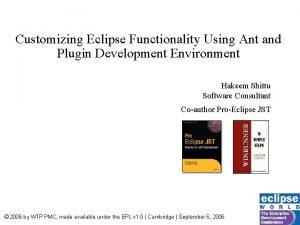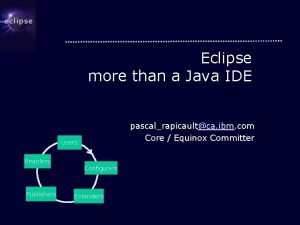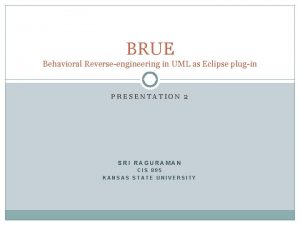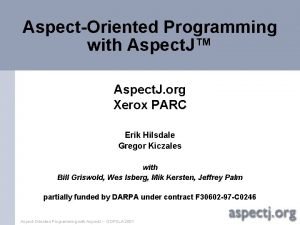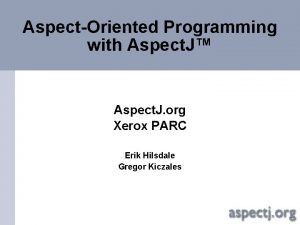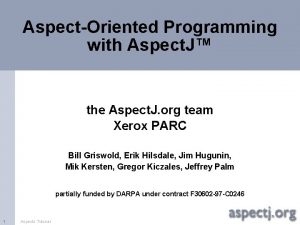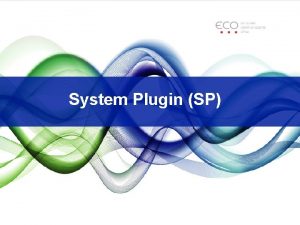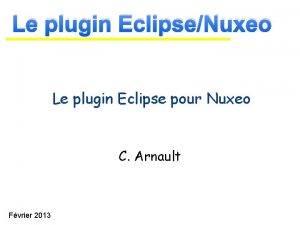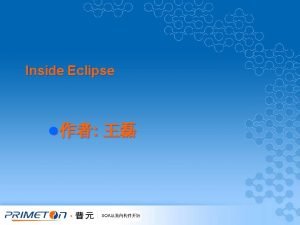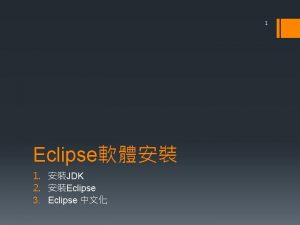AspectOriented Programming with the Eclipse Aspect J plugin














- Slides: 14

Aspect-Oriented Programming with the Eclipse Aspect. J plug-in David Gallardo

The problem • Object-oriented programming provides a solution for business logic, but other concerns complicate a clean OO design and implementation • Common services are often required: – – – Logging Authentication Persistence Instrumentation Etc. • These requirements lead to code unrelated to the business being scattered throughout the application and are called crosscutting concerns.

Crosscutting concerns

The solution: Aspect-Oriented Programming • Researchers at Xerox PARC start examining limitations of OOP in early 1990 s • Separation of concerns is identified as the key • Crosscutting concerns are implemented separately as Aspects. • Aspects are the fundamental unit in AOP and are equivalent to a class in OOP. • Aspects interact with an application at interesting and pre-defined points in its execution such as method calls and field assignments. These are called join points.

Programming in AOP • Decompose application into separate business and crosscutting concerns • Implement concerns as classes and aspects • Recompose business and crosscutting logic using an AOP compiler. This process is called weaving and the compiler that performs this is called a weaver.

Aspect. J: The first AOP language • Xerox PARC researchers develop Aspect. J, the first AOP language. • Aspect. J is a simple, well-integrated extension of Java • It was given to the Eclipse Consortium in early 2002 • Available on the Eclipse. org website

Installing the Eclipse Aspect. J plug-in • Available for 3. 1. from the update site: http: //download. eclipse. org/technology/ajdt/31/dev/update • Works in conjunction with Eclipse’s Java development tools. • This provides a source-to-bytecode weaver, based on the Eclipse Java compiler. • Plus views and perspectives that support for AOP programming.

Creating an aspect • You create an aspect in Eclipse pretty much like you do a class: – Create an Aspect. J project for it to live – Use the New wizard and select Aspect. • You’ll get something that looks like this: public aspect Example { } • If you named your aspect Example, it will be in a file named (by default) Example. aj

Identifying join points with a pointcut • A joint point or a set of joint points is identified with a pointcut expression. • A pointcut uses patterns and wildcards that match type, name and method parameters. • The following identifies calls to public methods of type void that begin with the letters “say”: pointcut talk() : call(public void say*(. . )); • The following identifies all public getter methods that return an int or a long: pointcut access() : call(int get*(. . )) || call(long get*(. . ));

Giving advice • Pointcuts only identify where an aspect should introduce behavior. They need to be associated with advice—a code body—in order to do anything. • Advice can run before or after a join point. • Advice can also run around a join point. Advice of this type can affect the execution of the join point —executing it conditionally, or, in the case of a method call, modifying the parameters.

Examples of advice • Here are some examples of advice for the pointcut talk from two slides ago: before() : talk() { System. out. println("Hello!"); } after() : talk() { System. out. println("Goodbye!"); };

Introductions • One more Aspect. J feature can be included in an aspect, an introduction, or inter-type declaration. • This allows the aspect to alter classes by adding fields or methods, altering class heirarchy, etc. • We won’t be using these here.

Eclipse Aspect. J support • Decorators in the editor view identify which methods and fields in a class have advice associated with them. • Cross References view provides details about advice are associated with each method or field, or methods or fields associate with each advice. • Aspect Visualization perspectives shows graphically which class is affected by each aspect. • Debugging support is extended to advice.

Eclipse Aspect. J demo • • Demonstrate how to install using Update Create an Aspect Project Create a class and an aspect and run Demonstrate editor support, outline, crossreference. • Demonstrate Aspect Visualization perspective with Eclipse-provided example
 Ant eclipse plugin
Ant eclipse plugin Oracle eclipse plugin
Oracle eclipse plugin Spring mvc project 없음
Spring mvc project 없음 Ibm java ide
Ibm java ide Jprobe eclipse plugin
Jprobe eclipse plugin Eclipse plugin
Eclipse plugin Eclipse javafx install
Eclipse javafx install Adt plugin eclipse
Adt plugin eclipse Uml diagram eclipse plugin
Uml diagram eclipse plugin Structure d'un texte
Structure d'un texte Lunar dan solar exo
Lunar dan solar exo Differentiate between lunar eclipse and solar eclipse
Differentiate between lunar eclipse and solar eclipse Sesslah
Sesslah What is system program
What is system program Greedy programming vs dynamic programming
Greedy programming vs dynamic programming
